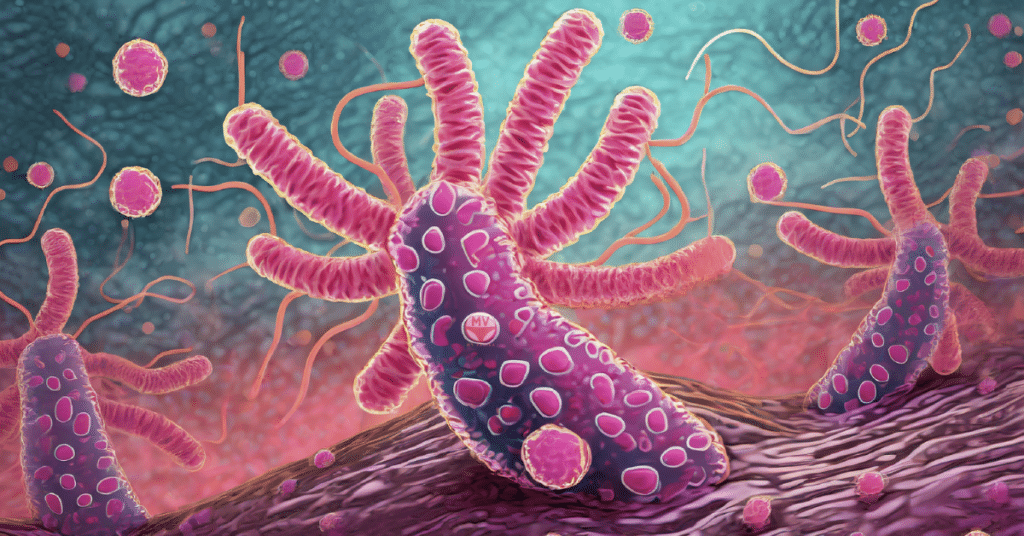Pseudomonas aeruginosa, a formidable bacterial pathogen, wreaks havoc through a spectrum of chronic and acute infections, including vaginal and urinary tract infections and dysbiosis. Bacterial vaginosis may include P. aeruginosa as a pathogenic player.
P. aeruginosa‘s notoriety escalates in individuals grappling with underlying conditions such as severe burns, cancer, cystic fibrosis, and hospital-acquired infections, often culminating in alarmingly high rates of poor outcomes.
Central to P. aeruginosa‘s persistence and virulence are various adhesion factors, including pili, flagella, and biofilms, allowing it to cling tenaciously to medical devices, water systems, and diverse surfaces.
The formation of biofilms by P. aeruginosa ushers in an era of chronic infections, with heightened resistance to conventional treatments like irradiation, disinfectants, immune responses, and antibiotics.
This resilience is largely attributed to the impervious extracellular matrix, or glycocalyx, which impedes antibiotic penetration into the complex polysaccharide network: the biofilm.
Consequently, biofilms have catalysed the proliferation of multidrug-resistant (MDR) P. aeruginosa strains, necessitating novel approaches for effective management.
How Cinnamomum from cinnamon acts against biofilms in P. aeruginosa
Enter Cinnamomum and its derivative compounds, demonstrating remarkable antimicrobial potential via various mechanisms. Cinnamomum and its derivative compounds have also been found to destroy microbial biofilms1.
One active component, cinnamtannin B1 from the cinnamon species Cinnamomum tamala, hinders biofilm formation and swarming motility in P. aeruginosa. It does so by suppressing the expression of fliC and rhlA, pivotal in flagella protein flagellin and rhamnolipid (a bacterial surfactant) synthesis2.
Furthermore, the power of Cinnamomum against P. aeruginosa biofilms lies in its adept inhibition of quorum sensing (QS), a prime modulator of virulence.3–5 Quorum sensing is a way that microbes communicate with one another and seem to direct group actions.
This pathogen boasts four QS systems (PQS, IQS, Las, and Rhl) orchestrating nearly 10% of the P. aeruginosa genome.
Recent studies reveal that Cinnamomum’s sub-inhibitory levels of cinnamaldehyde downregulate both the las and rhl QS systems by repressing transcription factors LasR and RhlR, curbing the production of key virulence factors like pyocyanin, elastase, and protease.4
Cinnamomum’s potential doesn’t stop here. It also curtails the production of Cyclic di‐guanosine monophosphate (c‐di‐GMP), a pivotal cytoplasmic signal governing various bacterial behaviours, including biofilm life cycles.6
By disrupting transmembrane potential and swarming motility, Cinnamomum destabilises biofilms and impairs c‐di‐GMP expression, rendering P. aeruginosa more susceptible to host immune responses and other antibiofilm agents.
C‐di‐GMP is a critical cytoplasmic signal and second messenger that controls virulence, cell cycle propagation, motility, and other behaviours such as biofilm life cycle in several bacteria.
This multifaceted approach positions Cinnamomum as a promising contender in the fight against P. aeruginosa biofilm infections.
References
- 1.Vasconcelos NG, Croda J, Simionatto S. Antibacterial mechanisms of cinnamon and its constituents: A review. Microbial Pathogenesis. Published online July 2018:198-203. doi:10.1016/j.micpath.2018.04.036
- 2.Lakshmanan D, Harikrishnan A, Vishnupriya S, Jeevaratnam K. Swarming Inhibitory Potential of Cinnamtannin B1 from Cinnamomum tamala T. Nees and Eberm on Pseudomonas aeruginosa. ACS Omega. Published online October 3, 2019:16994-16998. doi:10.1021/acsomega.9b02471
- 3.Ahmed SAKS, Rudden M, Smyth TJ, Dooley JSG, Marchant R, Banat IM. Natural quorum sensing inhibitors effectively downregulate gene expression of Pseudomonas aeruginosa virulence factors. Appl Microbiol Biotechnol. Published online March 9, 2019:3521-3535. doi:10.1007/s00253-019-09618-0
- 4.Kalia M, Yadav VK, Singh PK, et al. Effect of Cinnamon Oil on Quorum Sensing-Controlled Virulence Factors and Biofilm Formation in Pseudomonas aeruginosa. Leoni L, ed. PLoS ONE. Published online August 11, 2015:e0135495. doi:10.1371/journal.pone.0135495
- 5.Alva PP, Suresh S, Nanjappa DP, et al. Isolation and identification of quorum sensing antagonist from Cinnamomum verum leaves against Pseudomonas aeruginosa. Life Sciences. Published online February 2021:118878. doi:10.1016/j.lfs.2020.118878
- 6.Topa SH, Subramoni S, Palombo EA, Kingshott P, Rice SA, Blackall LL. Cinnamaldehyde disrupts biofilm formation and swarming motility of Pseudomonas aeruginosa. Microbiology. Published online September 1, 2018:1087-1097. doi:10.1099/mic.0.000692
The most comprehensive vaginal microbiome test you can take at home, brought to you by world-leading vaginal microbiome scientists at Juno Bio.
Unique, comprehensive BV, AV and 'mystery bad vag' treatment guide, one-of-a-kind system, with effective, innovative treatments.
Promote and support a protective vaginal microbiome with tailored probiotic species.






